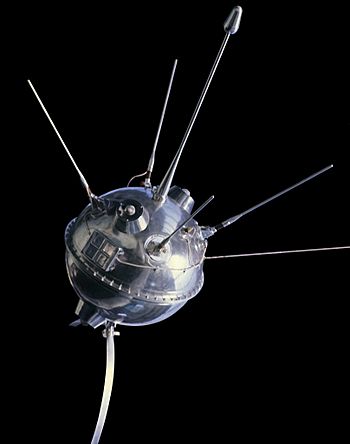Luna 1 facts for kids

A museum replica
|
|
| Mission type | Lunar impactor |
|---|---|
| Operator | Soviet Union |
| Harvard designation | 1959 Mu 1 |
| Mission duration | "Approximately 62 hours" |
| Spacecraft properties | |
| Manufacturer | OKB-1 |
| Launch mass | 361 kilograms (796 lb) |
| Start of mission | |
| Launch date | January 2, 1959 16:41:21 UTC |
| Rocket | Luna 8K72 |
| Launch site | Baikonur 1/5 |
| End of mission | |
| Last contact | "Approximately 62 hours after launch" |
| Orbital parameters | |
| Reference system | Heliocentric |
| Semi-major axis | 1.146 AU |
| Eccentricity | 0.14767 |
| Perihelion | 0.9766 AU |
| Aphelion | 1.315 AU |
| Inclination | 0.01 degrees |
| Period | 450 days |
| Epoch | 1 January 1959, 19:00:00 UTC |
| Lunar flyby (failed impact) | |
| Closest approach | 4 January 1959 |
| Distance | 5,995 kilometres (3,725 mi) |
Luna 1 (also known as the First Cosmic Ship, Cosmic Rocket and Mechta (Russian: Мечта, Literal translation: Dream)) was a space probe of the Soviet Union. It was the first mission in the Luna programme and it was the first spacecraft to reach the Moon. Luna 1 made some key scientific discoveries and it is one of the best achievements of the Soviet Union space programme.
Contents
Design
The spacecraft was sphere-shaped. Five antennae came out of one end. Instrument ports came out of the surface of the sphere. It also had various metallic emblems with the Soviet coat of arms.
Instruments
Luna 1 had radio equipment, a tracking transmitter and a telemetering system for communication with Earth. The spacecraft carried several scientific devices too. These included a magnetometer, a device for measuring magnetic fields, a scintillation counter, a device for detecting high energy particles and a geiger counter, a device for measuring radiation. Luna 1 also carried a micrometeorite detector and other equipment.
Mission
The space probe was launched on January 2, 1959 at Baikonur Cosmodrome by a SS-6 Sapwood rocket. The launch was successful and Luna 1 became the first man-made object ever to reach the escape velocity of the Earth.
On January 3, 1959, the spacecraft released a cloud of sodium gas so that astronomers could track the probe and also to serve as an experiment on the behaviour of gas in space.
Luna 1 was intended to impact the Moon's surface. However, on January 4, 1959, it passed within 5995 km of the Moon and began to orbit the Sun between the orbits of Earth and Mars, where it is still orbiting now, on a 450 day orbit. Thus, Luna 1 became the first spacecraft to orbit the Sun.
Images for kids
See also
 In Spanish: Mechta para niños
In Spanish: Mechta para niños


